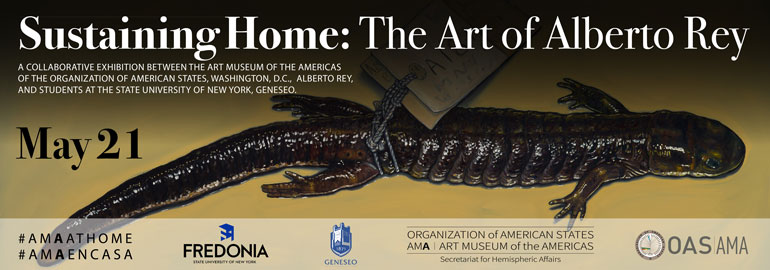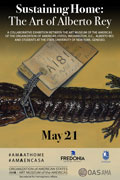
Christine Grace is a senior at Geneseo with a major in Art History. She says that working on this exhibition made her realize that our experiences are universal, and that it has been enlightening to be a part of this exhibition. She earned Honorary Mention for The Pam Eder Prize for Excellence, Annual Art History Department Symposium, SUNY Geneseo (2021).
On social media May 25, 2021
Madonnas of Western New York Series
by Christine Grace
Alberto Rey’s series of paintings, Madonnas of Western New York (1991-1993) ties spirituality to geographic landscape through its iconography and the fleeting feeling of motion and time passing. The series was painted as a record of Rey’s emotional response to the time soon after he and his wife, Janeil Rey, first moved to Fredonia/Dunkirk, in Western New York, in 1989. As they explored their new home, while driving through surrounding towns, Rey noticed they would regularly return to the same places. The regularity of return to specific places provided Rey with a level of inner fulfillment that grounded him in the area and made it begin to become “home.” On their Sunday drives, while others went to churches, the Reys identified their drives with the spiritual regularity of the day of rest and the sights they saw became transformed into the “Madonnas.”
The “Madonnas” were painted on treated wood, which Rey built into boxes, painting the images of Western New York State and its icons on their front. The “background” of the boxes are composed of linear forms related to his Binary Forms Series, providing continuity with the earlier series related to his marriage. These painted areas are in colors which evoke Western New York State’s light and scenery. Outstanding in this group is JC’s Hotdog Stand, Lake Shore Drive and Route 90 Overpass, all painted in oils on wood. The figures represented in JC’s Hotdog Stand and Lake Shore Drive were inspired by the retablos of paintings from art museums Rey visited in Mexico City, including Museo Franz Mayer. Rey liked the idea of there being a spirit of protection from his past experiences that he brought from Mexico to Western New York. In these combinations of Mexican art and New York State scenes, he found aesthetic and symbolic resonance, as he considered the Madonnas as personal retablos/shrines, used in Latin America, when praying for protection. Thus, the Madonnas of Western New York Series combined elements of Art History, personal memories and images of spirituality with American scenery, as Rey explored his personal identities and his new home.
Alberto Rey’s Madonnas of Western New York Series have the ability to connect with others who search for home and, for me, the series was impactful because, upon seeing them, I felt so reminded of my own experiences of living in Western New York as a student at SUNY Geneseo. As a senior in college, about to leave Geneseo and Western New York State, studying Rey’s images brought back a series of memories from my time at Geneseo, which was cut short last year by the pandemic and other circumstances. It felt personal and purposeful to see these works, and they have had an emotional impact on me for which I’m grateful to Rey. When I look at these works, I experience the spiritual connection I have to my home in this specific place in Western New York, where each fall had its own share of excitement in a way very similar to his experience. The Madonnas series highlights that human experiences are shared and are not isolated, even if they at first seem to be so and Rey’s paintings thereby offer a forum for an examination of the impact environments have on our inner reality. Rey’s personal experience thus becomes universal and able to be shared by others who have experienced similar emotions rooted in comparable places.
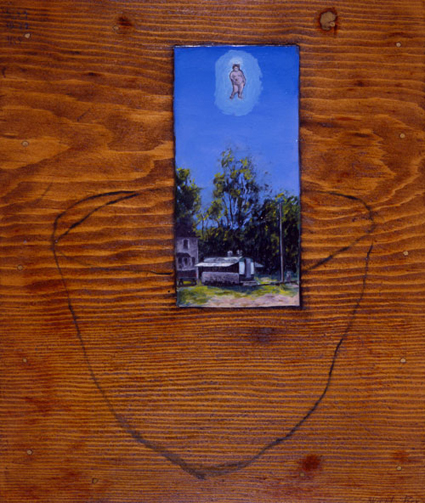
Madonnas of Western New York Series: JC’s Hot Dog Stand, 1991-1993, Oil on Wood
Alberto Rey’s JC’s Hotdog Stand shows a rural hotdog stand, which was once located near Rey’s home, as seen from a car on a summer day. The business closed a couple years after the painting was finished and is memorialized by it. Rey’s JC’s Hot Dog Stand, shows an in-depth view into the psychological and spiritual reality that exists in our daily life, enabling us to cultivate our inner worlds. From 2017 until 2019 arriving in Geneseo for the fall semester had always been an intoxicating mixture of excitement, vigor, and energetic newness. JC’s Hotdog Stand symbolically reminded me of new beginnings as well as all of my past fall semesters. I remembered my first year, my bid to Phi Kappa Pi and the fall of last year, when I moved into my off campus house. I remembered how it felt to be driving down Court Street in August and my freshman year when I first met friends who made me feel at home in Geneseo and the attachment I have to that first house, which became home. Thus, Rey’s image of home resonates, for me, in my memories of one of my homes as it does for him in his search for home.
Alberto Rey’s JC’s Hotdog Stand also caused me to remember other aspects of my time in Geneseo and Western New York State. The painted scene has a figure hovering above it. To me, the floating figure looked like a reimagined “Botticelli Venus,” even though it is a Mexican, pottery statuette. The image, for me, linked Renaissance art to contemporary Western New York State, which made me connect to my interest in Art History in an indirect way and to my college work at SUNY Geneseo. Just as Rey had grounded these landscapes with spirituality in his pictorial representations, my perception of Venus above the mundane landscape was impactful because it summarized the psychological and spiritual aspects of my experiences in a Western New York college town and it reminded me of when I started dating at Geneseo. In a roundabout way, Rey’s image of his early marriage and the road trips he and Janeil made brought me to memories of comparable experiences of companionship and travel and making a new place home. Deeply personal, yet able to communicate experiences shared by others, Rey’s Madonnas of Western New York Series is a group of signature works that reach across cultures and time to connect Rey to his audiences.
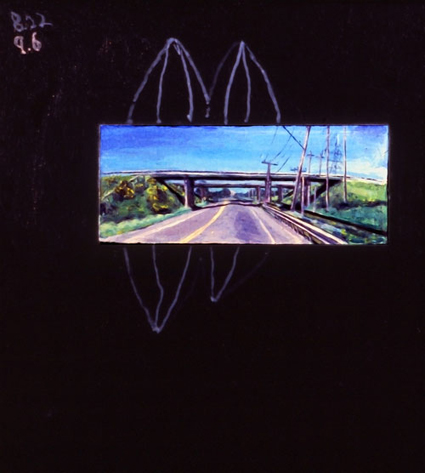
Madonnas of Western New York Series: Route 90 Overpass, 1991-1993, Oil on Wood
Alberto Rey’s Madonnas of Western New York State: Route 90 Overpass reflects a specific stretch of Route 90 that became familiar to him. The implied movement of the road and the lighting and season connected his experience for me to summer departures and drives in the area, taken in May at the end of Spring Semester at SUNY Geneseo. For anyone who has lived in Western New York State, Rey’s series is an identity marker that he shares with this area’s settled and transient populations. My perception of Rey’s message in Route 90 Overpass was that he captured and radiated the feeling of saying goodbye to one home, while moving to another, yet knowing that you will be happy to return to the place you are leaving behind. In this connection, it becomes clear that Rey’s representation of movement through these country roads connects his vision to that of others who find home through movement to different places.
Alberto Rey’s Madonnas series is a connector for me to a past I share with him and this Fall this connection took on new meaning, after learning that he is an Orvis Guide. In driving past an Orvis Store in Manchester, Vermont, I was suddenly reminded of Rey’s work and thought - wow, that’s the most beautiful Orvis store I’ve ever seen. I didn’t know Orvis even had stores. Then we drove past the Fly Fishing Museum and it clicked in my head that this is a town related to Alberto Rey’s love of fishing! I almost blurted out Alberto Rey! Like someone would blurt out Deer! When driving past a herd of deer. But I didn’t. Instead, I thought about JC’s Hotdog Stand and how the icon reflected the qualities of Venus to me and Rey’s memories connected to mine. Although I was in Vermont, the feeling that I was supposed to be in this town in Western New York was inescapable. Every curve in every road was reminiscent to me that I was missing something and that something was missing for me brought to my consciousness by Rey’s works. In making his memories visible, Rey enables others to bring their memories to life and become aware of how it is possible for seemingly mundane landscapes to bring a sense of spiritual fulfillment. Interestingly, it had been this trip to Manchester, in February of 2021, that really brought out my understanding of the Madonnas of Western New York State Series as works that reflected movement, spirituality and temporal transcendence.
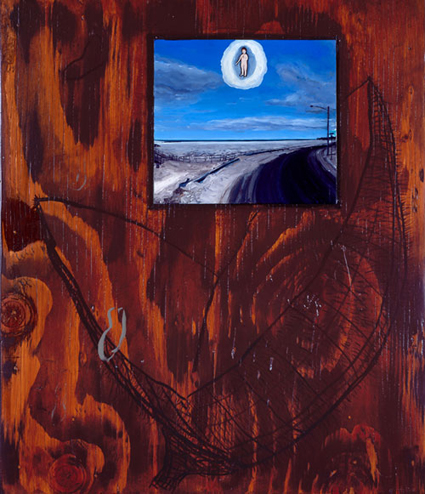
Madonnas of Western New York Series: Lake Shore Drive, 1991-1993, Oil on Wood
In Rey’s Lake Shore Drive, we see a representation of an impression of a winter’s drive on a Western New York State road, above which hovers a glowing “Madonna.” When I saw this image, it immediately reminded me of the drive I used to make up Volunteer Road, in Geneseo, to go to Walmart or Dunkin’ Donuts and it reminded of leaving Geneseo to go home to Westchester at the end of Fall Semester. Rey’s image is reminiscent of some of the gas stations where we regularly stopped on the drive, with an almost eerily familiar, frozen over road surface, coated with blackened snow denoting the freezing cold outside. Those drives to and from Geneseo in the winter were always wrought with the promise of return and Rey’s image connected me to my own trips with roommates and my homes in Western New York State. Hence, his personal experience is able to connect others to this shared landscape. The evocation of travel by car in Lake Shore Drive is relevant because it seems that in moments of transience, our spiritual connection with our environment shifts as we traverse the geography.
Rey’s Madonnas of Western New York are an autobiographical series. Yet, his meditation on being home also touched me and in looking at his work, I realized that I too had found a home in Western New York State. As did Rey, I came to Western New York as a stranger and the area took me in, through my association with SUNY Geneseo’s academic culture. As a town, Geneseo is a specific place that is much like many other New York, small towns. But through association, I grew to take in its personality and through Rey’s work, I better understood the deeper meaning of place and identity in forming home. Rey reminds us that - if you take a closer look - this landscape, once unfamiliar, is a path towards seeking deeper meaning beyond outward appearance. Thus a spiritual bond to a mundane town in Western New York can form after time and experience creates memories that enable one to say “I’m going to call this place my home.”

